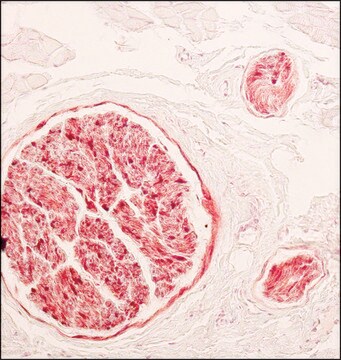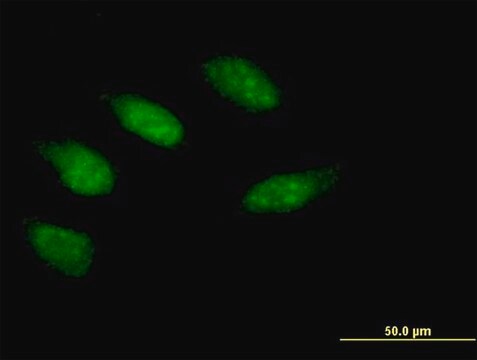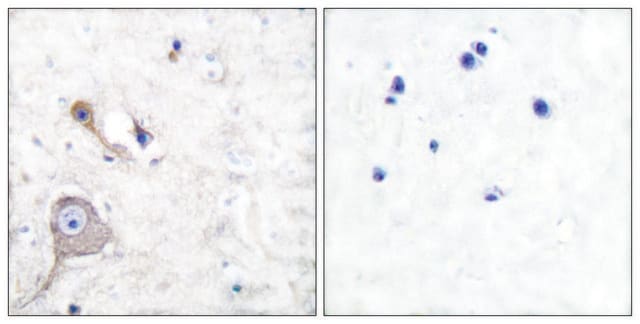일반 설명
S100 gene is mapped on human chromosome 21q22.3 and codes for an acidic calcium binding protein B, which weighs 21 kDa. The gene is predominantly expressed in astrocytes, glial cells, Schwann cells and also found in adipose cells, skin, glioblastoma multiforme and melanoma. The protein is localized in extracellular space and cytoplasm.
S100B (S-100β Subunit) belongs to the S100 family of calcium-binding proteins. It is expressed in melanocytes.
S-100 is a set of small, thermolabile, highly acidic dimer proteins of approximately 20kDa which are widely distributed in different tissues. Dimeric combinations of two chains, the α-chain (93 amino acids,10.4kDa) and the β-chain (91 amino acids, 10.5kDa), form the three known subtypes of S-100: S-100ao (αα), S-100a (αβ) and S-100b (ββ).
Monoclonal Anti-S-100 (β-subunit) (mouse IgG1 isotype) is derived from the SH-B1 hybridoma produced by the fusion of mouse myeloma cells and splenocytes from an immunized mouse.
특이성
This antibody recognizes an epitope located on the β chain (i.e. in S-100a and S-100b) but not on the α chain of S-100 (i.e. in S-100a and S-100ao). In ELISA, recognition of S-100 subunit by clone SH-B1 is independent of Ca2+. The product does not react with other members of the EF-hand family such as, calmodulin, parvalbumin, intestinal calcium-binding protein and myosin light chain. In immunohistochemistry, the antibody detects normal and neoplastic S-100 β subunit-containing cells (e.g. Schwann cells, chondrocytes, melanocytes, and melanotic tumors) in protease-digested, formalin-fixed, paraffin-embedded tissues.
애플리케이션
Monoclonal Anti-S-100 (β-Subunit) antibody produced in mouse has been used in the following:
- ELISA
- Immunofluorescence
- Immunohistochemistry
- Western blotting
생화학적/생리학적 작용
Increased expression of S100 is observed in neuronal damage and thus, serves as a biomarker for detecting brain damage and also in several cancers. Also, it is highly permeable through the blood-brain barrier. The gene is known to be associated with cancer progression.
S100β participates in multiple cellular activities including cell growth, cell structure, cell-cell communication, energy metabolism, contraction, and intracellular signal transduction. In utero exposure to cocaine resulting in aberrant S100β levels is linked with neurobehavioral abnormalities and microcephaly. Fetuses with anencephaly show aberrant cell immunoreactivity. Increased levels of this protein are found in plasma of patients with brain damage. S100β is a candidate biochemical marker for spinal cord injury (SCI). Elevated expression of this protein in subpopulations of reactive astrocytes might be linked with hippocampal structural reorganization post-kainic acid (KA)-mediated neurodegeneration.
물리적 형태
The product is provided as ascites fluid containing 15 mM sodium azide as a preservative.
저장 및 안정성
For continuous use, store at 2-8 °C for up to one month. For extended storage, the solution may be frozen in working aliquots. Repeated freezing and thawing is not recommended. Storage in "frost-free" freezers is not recommended. If slight turbidity occurs upon prolonged storage, clarify by centrifugation before use.
면책조항
Unless otherwise stated in our catalog or other company documentation accompanying the product(s), our products are intended for research use only and are not to be used for any other purpose, which includes but is not limited to, unauthorized commercial uses, in vitro diagnostic uses, ex vivo or in vivo therapeutic uses or any type of consumption or application to humans or animals.















